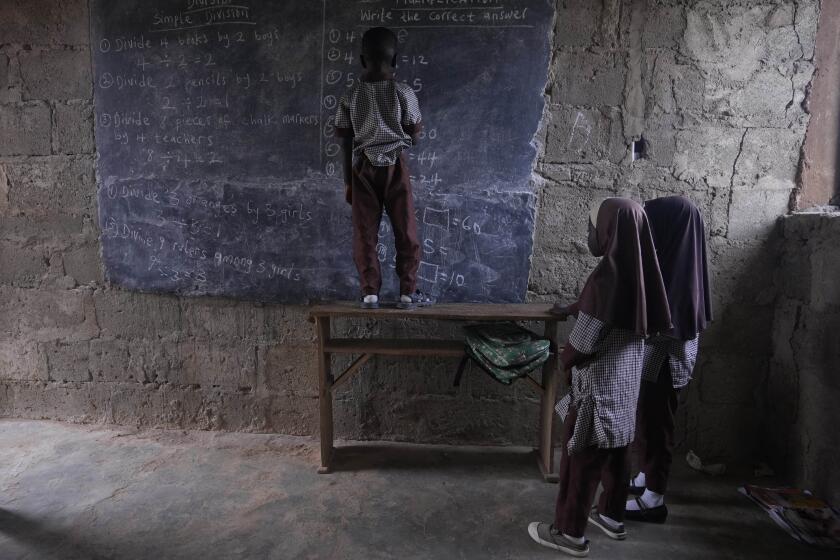Life Goes Underground in a Capital Under Siege : Nagorno-Karabakh: Frightened citizens find refuge in cramped spaces beneath buildings as battles continue.
Gohar Babayan, 2 months old, has spent her entire life in the gloomy, hellish nether world that is now the lot of the people of Stepanakert.
The tiny black-eyed girl has never seen the sun, save for a brief trip home from the maternity ward. But she may be one of the lucky ones. For Gohar has a crib all to herself in the small cellar where her family has sought refuge.
There is yellowish light from a flaming gas jet, plenty of warmth from a wood stove.
Compare that with the misery of the 500 people who have crammed their metal-framed beds into a space smaller than a basketball court beneath the Stepanakert House of Ceremonies. Light for all must come from a solitary flickering kerosene lantern. Scores of children at play run screaming through the penumbra; there is the stink of human waste, and one’s nostrils fill with dust from the pounded-dirt floor.
People here are in their third month of life in the catacombs, and some are desperate.
“You see the dirt and conditions we live in,” Asya Goryakyan, an elderly woman who had wrapped her face in a blue, red and white shawl to keep out the clammy air, told an appalled visitor. “I don’t know whether we are fated to live or die, but if we must die, better that it be right now than to live like this.”
Like terrified mice, many of the people of Stepanakert are afraid to venture above ground.
In the besieged wartime capital of the self-proclaimed Nagorno-Karabakh Republic, life has reverted to Stone Age urgency and precariousness. Take, for example, drinking water, a pressing concern since the Azerbaijanis shut off electricity to pumps that drive the waterworks in this predominantly Armenian city of 70,000.
Three spring-fed faucets in the city center now must supply thousands of households. In the morning, when the shellfire usually lets up, housewives, children and old men venture above ground and lug milk cans, buckets, teakettles and jerrycans to the taps behind the Drama Theater.
The water trickles forth so slowly--only one faucet really works right--that it may be a month before one’s turn comes.
The trees in the park by Shaumyan Stadium are being hacked down by people needing firewood. Gasoline can only be obtained with a voucher from the military commander’s office and is critically scarce, so the streets are mostly empty, save for people pushing pushcarts laden with water.
Only telephone service inside the city still functions; access to the rest of the world has been cut off. A few offices have the high-frequency phone system known as Veche, but it is only good for contacting other government facilities in the former Soviet Union.
In her underground retreat, Lidia Airepetyan awakened one night because of a stirring by her head. It was one of the fat rats that run along the water pipes. She shuddered in terror, then mustered the courage to pound the pillow and scare the rodent away.
“For three months, we haven’t washed; we have forgotten what a bath is,” said the teacher and mother of three children. She and 36 other families living under their apartment house have no bread since bakeries have shut, so they hull raw wheat and boil it instead. “We basically are surviving off tea,” Airepetyan said. “There are no more noodles, no rice.”
With numbing frequency, Alazan rockets--designed to break up hailstorms--and cannons roar from neighboring Shusha, then fall somewhere in Stepanakert. This month, the Azerbaijanis began using a new and awful instrument of war--a Soviet-made, multiple-rocket battery, which the Armenians claim is outlawed by international conventions.
The modest ground-floor home of Greta Mkrtchyan, shaded by a grape arbor, seems to have been one of the weapon’s first victims. Some kind of projectile exploded out front and blew in the windows, chewed a cheap rosewood wall cabinet to bits and decapitated a Soviet-made Fiat sedan, roasting the beige paint a matte gray.
“ Eh! Eh! Eh! “ shrieked Mkrtchyan in despair, hugging her ragged sweater closer around her as she ran through the shambles. “It took 40 years for us to build this home; now I have nothing left, nothing!”
Luckily for the people of Stepanakert, a natural gas pipeline supplying an estimated 1 million people in Azerbaijan also runs through their city. The Baku government has not cut it off, the thinking here goes, because other areas of Azerbaijan would be deprived, too.
Slowly, tubing is being snaked into the cellars, where the flaming gas is used as a source of both light and heat.
Last month, each resident got a kilogram, or a little more than two pounds, of flour and an equal amount of sugar. The work force hasn’t been paid for at least four months, since there is no currency brought in to give them.
With food supplies from outlying areas hampered by the siege, Stepanakert is depending more and more on provision-laden helicopters that risk the flight over the mountains from Armenia. The elected leader of the territory’s legislature, Arthur Mkrtchyan--no relation to Greta Mkrtchyan--worries aloud about a looming famine.
“People have stocks of flour and grain that are quite limited and that are starting to run short,” the 33-year-old former museum director said. “Already some families in Stepanakert are hungry.”
Dressed in his bulky overcoat, Mkrtchyan recently received a Western reporter in his frigid second-floor office. Since then, government headquarters is said by Armenians to have been wrecked in an Azerbaijani rocket salvo and evacuated by Mkrtchyan’s leadership, which reportedly fled Stepanakert on Monday to escape virtually nonstop shelling and major fires.
Using their ingenuity, Stepanakert tinkerers have harnessed the natural gas pipeline, tapping into it with power generators that are supposed to run on diesel fuel. Electric lights now burn in a handful of public buildings downtown.
In one of the few places with both heat and electric light--the basement of government headquarters--the local maternity hospital has commandeered what were once the archives, since its own building was hit by a bomb.
So far, 94 babies have been born during the siege of Stepanakert, often to mothers who must be brought in by armored cars.
“Normal births practically no longer take place,” Dr. Brina Marutyan, the head physician, said sorrowfully. “A woman will go into labor right away if she hears or feels the concussion of an Alazan.”
The stress, privations and grime of war have caused an increase in premature births and health complications such as severe bleeding, septicemia and hepatitis, the physician said. Officials here worry that citywide epidemics may break out in the spring because of the forced intimacy in shelters and the unsanitary conditions in makeshift underground latrines.
No one seems to know how many people have been killed since the Azerbaijani shelling began in December; Stepanakert officials put the death toll at 60 to 80, with at least 200 wounded. Even those untouched call themselves victims.
“Our city is under blockade,” Marutyan said. “So are our souls.”
More to Read
Start your day right
Sign up for Essential California for news, features and recommendations from the L.A. Times and beyond in your inbox six days a week.
You may occasionally receive promotional content from the Los Angeles Times.






